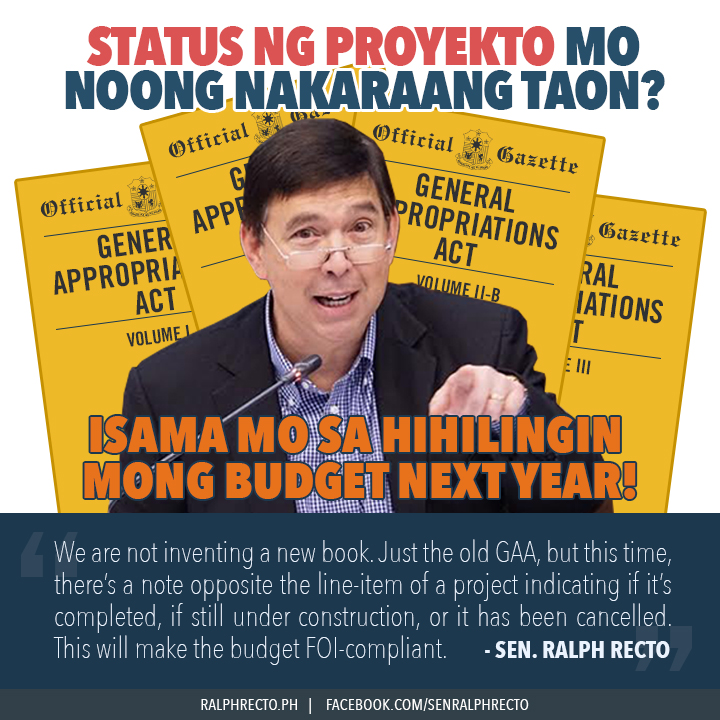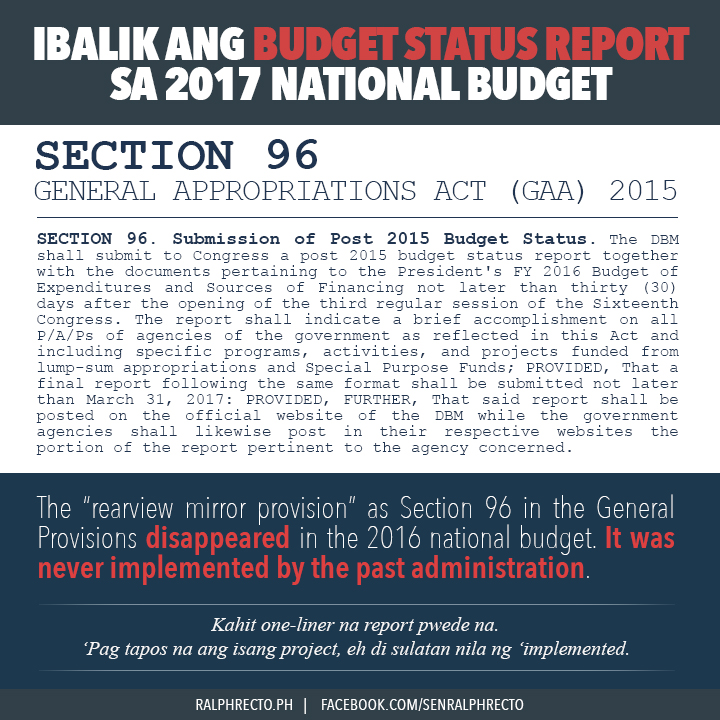Para hindi clueless, reinstall the ‘rearview mirror’ provision in GAA –Recto
Senate Minority Leader Ralph Recto today called for the reinstallation of the “rearview mirror” in the national budget so that policymakers and the public would know if projects funded in past general appropriations laws have indeed been implemented.
Thick the 5,097-page 2017 national budget packet may be, “it does not, however, tell what happened to funds appropriated in the 2016 budget,” Recto said.
“It is one flaw of the budgeting system,” Recto said. “There’s no way of knowing if the projects lovingly enumerated in the previous year’s budget have been completed, or scuttled, or realigned.”
To cure this defect, Recto is reviving his proposal for an “easy-to-comply” new budget “accountability form” which reports on the status of projects funded by the immediate General Appropriations Act (GAA).
Recto said the report “will use the GAA format, which will be returned to us with status reports opposite the projects.”
“If there’s a line-item in the 2017 GAA for a P100-million road in Mindanao, then what we want is for the government to include in the 2018 budget documents the same GAA, annotated with status reports,” Recto said.
“If the 2017 GAA authorizes the recruitment of, say, 10,000 new policemen and 50,000 new teachers, then what we want is for the executive to later indicate in the proposed 2018 budget a note stating the number of policemen and teachers actually hired,” he added.
Recto said the 2015 GAA carried the “rearview mirror provision” as Section 96 in the General Provisions.
“But this disappeared in the 2016 national budget. It was never implemented by the past administration. At wala ito sa proposed 2017 national budget. What is provided there are hard-to-access reportorial requirements,” Recto said.
Recto defended his proposal as easy to implement. “Formatting-wise, hindi mahirap, kasi isang Excel column lang daw ang idadagdag.”
“We are not even inventing a new book. Just the old GAA, but this time, there’s a note opposite the line-item of a project indicating if it’s completed, if still under construction, or it has been cancelled. This will make the budget FOI-compliant,” he said.
“One-liner na report pwede na. ‘Pag tapos na ang isang project, eh di sulatan nila ng ‘implemented,’”he said.
Recto urged the Duterte administration to embrace his idea as it would lead to more transparent budgeting.
He said it is hard to track the status of a project because forms used during “budget accountability phase” are different from those used during “budget proposal and authorization.”
“The National Expenditure Program evolves into the General Appropriations Bill and the latter morphs into the GAA, which in turn is used as a budget release document,” Recto said.
“But what is supposed to be the seamless progression of using one reference format stops at post-implementation kasi iba na ang format. Mahirap kunin sa COA. But this can be solved by using the same GAA as the report card of fund utilization,” he said.
Recto said if agency heads were able to itemize the projects when they were asking for money, “then what would prevent them from reporting how the money was spent using the GAA format?”
“Budgeting is not just about looking forward. It also entails a great deal of looking back,” he said. “While the budget documents show us the road ahead, it doesn’t report on the road previously travelled.”
RELATED ARTICLES:
-
18 NOV 2016: Itemizing ‘mega lump sums’ makes budget FOI compliant, prevents underspending
-
19 NOV 2014: Budget needs rearview mirror



